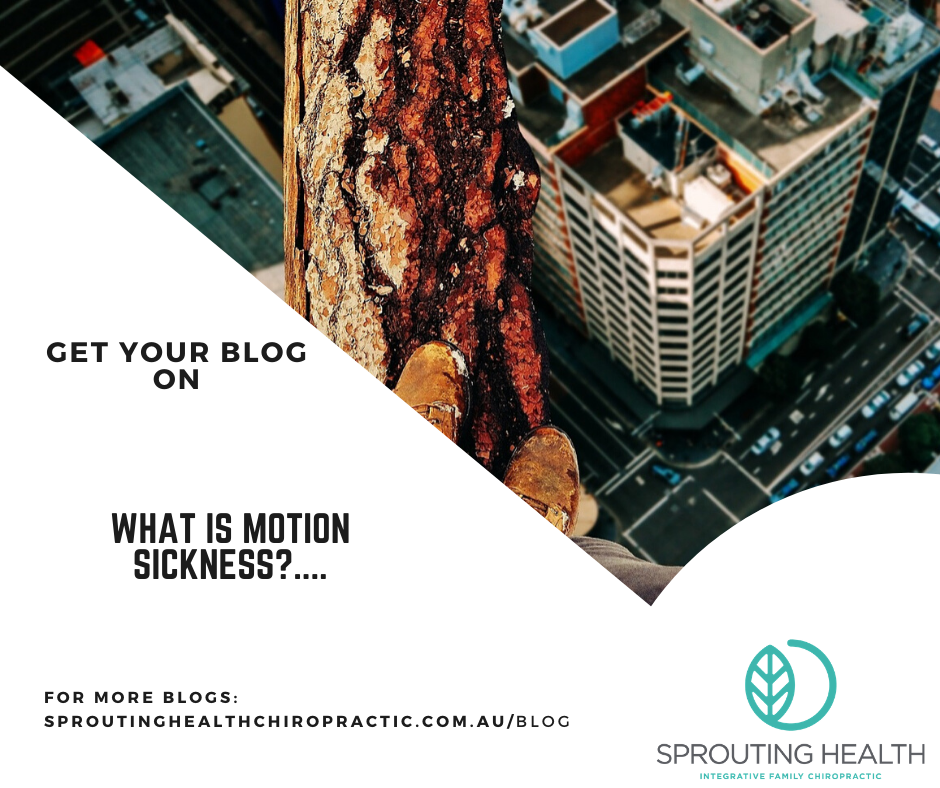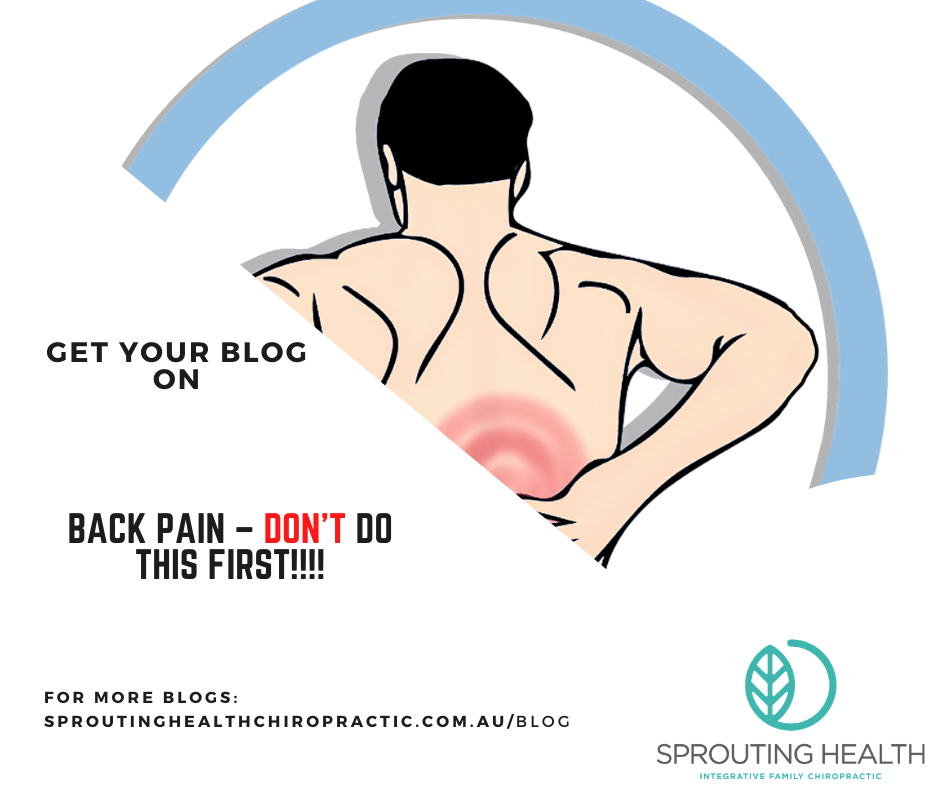 Motion sickness can happen when you are on a roller coaster ride, on a boat, or sitting in the backseat of a car. Common symptoms can range from mild to serious, and can include dizziness, generally feeling unwell and tired, excessive production of saliva, headache, nausea, vomiting, burping and sweating (1). Most people nerve ask why, but rather take the magic pill. Motion sickness occurs when there is a mismatch between the three key system within the body. “Balance is comprised of an integration of three main senses: visual senses, inner ear senses and proprioception or information from the joints. In terms of where in the body the proprioceptive system is most important, or where we can have the most influence, the cervical spine and particularly the top two joints in the neck have an exponential amount of leverage. That influences this. Straight away, chiropractors can have a great impact just on that.” said Dr Rinaudo(2). Dr Carlo Rinaudo’s (PhD candidate on the topic of vestibular rehabilitation) work is focused on balance and dizziness conditions. He said evidence is now showing us that the connection between the vestibular system and the spine is huge(2). On top of a Chiropractor’s work on the upper cervical spine, feedback from all joints on the body are being sent and processed by your brain. When there is an error in the joint position there is an error in the feedback. We have research showing spinal adjustment have great impact on balance improvement and falls prevention in older population(3). With limited research we have to date, we cannot claim chiropractic can cure motion sickness. However, chiropractic may help improve your overall body balance. A quick challenge is to stand on one leg for 10 seconds, like how a flamingo would, with eyes closed. If you are struggling with the challenge, maybe it’s time to have a chat with us and see how we may be able to help. References
1. Goverment VS. Motion Sickness 2020 [Available from: https://www.betterhealth.vic.gov.au/health/HealthyLiving/motion-sickness. 2. Foundation ASRF. Motion Sickness: More Than Nausea And Vomiting 2016 [updated 29 March 2016. Available from: https://spinalresearch.com.au/motion-sickness-nausea-vomiting/. 3. Holt KR, Haavik H, Elley CR. The effects of manual therapy on balance and falls: a systematic review. Journal of manipulative and physiological therapeutics. 2012;35(3):227-34.
0 Comments
Opioid use in Australia and internationally has been increasing rapidly over the last 2 decades (1). Risks associated with the use of prescription opioid analgesics are well known. (2). Recent guidelines have recommended non-pharmacological treatment as the first line of approach to treating back pain, with consideration of opioids only as the last treatment option or if other options present substantial risk to the patient (2). Do you or a loved one use any form of opioids? This is an important article that could make the world of difference to you. “A retrospective claims study of 165,569 adults diagnosed with low back pain found that utilisation of services delivered by DCs was associated with reduced use of opioids” (3) Drug overdose deaths in 2017 increased by almost 10% compared to 2016, with opioids accounting for almost 48,000 cases (4), Among US adults prescribed opioids, 59% reported having back pain (5). So it is a prevalent issue, and it’s important that we consider non-pharmacological treatments to address spinal pain. In a recent research article, health insurance claims were analysed, it was found that among patients with spinal pain disorders, for those who received chiropractic care, the risk of filling a prescription for an opioid analgesic over a 6 year period was reduced by half compared to those who didn’t receive chiropractic care (2). It was also found that those who saw a chiropractor within 30 days of being diagnosed with spinal pain, the reduction in risk was much greater compared to those who visited the chiropractor after the acute phase (2). So depending on the cause, chiropractic care should be considered to reduce the risk of requiring an opioid prescription. Though it’s common knowledge, it is better to get to the issue sooner rather than later for better outcomes. So if you want to find out if chiropractic care may help manage spinal pain for you or your loved ones, have a chat with one of our chiropractors to see how they can assist. “Health outcomes are more likely to be better when issues are addressed earlier!” References 1.Lalic, S., Ilomäki, J., Bell, J.S., Korhonen, M.J. and Gisev, N., 2019. Prevalence and incidence of prescription opioid analgesic use in Australia. British journal of clinical pharmacology, 85(1), pp.202-215. 2. Whedon, J.M., Toler, A.W., Kazal, L.A., Bezdjian, S., Goehl, J.M. and Greenstein, J., 2020. Impact of Chiropractic Care on Use of Prescription Opioids in Patients with Spinal Pain. Pain Medicine. 3. Rhee Y, Taitel MS, Walker DR, Lau DT. Narcotic drug use among patients with lower back pain in employer health plans: A retrospective analysis of risk factors and health care services. Clin Ther 2007;29(Suppl):2603–12. 4. US Department of Health and Human Services. Facing Addiction in America: The Surgeon General’s Spotlight on Opioids. Washington, DC: Office of the Surgeon General, US Department of Health and Human Services; 2018. 5. Hudson TJ, Edlund MJ, Steffick DE, Tripathi SP, Sullivan MD. Epidemiology of regular prescribed opioid use: Results from a national, population-based survey. J Pain Symptom Manage 2008;36(3):280–8. Over the last couple of months, we have been talking about the impact of Covid-19, the stress, the isolation, etc. Today, I want to talk about the impact of working and studying at home can have. This is mostly driven by where and how we are using our devices. In bed, on the couch, at the kitchen table. We are not using a proper set up with ergonomics in mind! We have previously talked about how to set up your work station with proper ergonomics, so check out our previous blogs and videos. What I want to talk about today, is how these poor choices in posture can impact on your wellbeing. For example, it has been said for a long time that a slumped posture is a diagnostic feature of depression. (2) One recent study looked at what happens when we straighten out our posture. They found an increase in arousal, a positive affect and lower levels of anxiety. (2) Another study found that improving our posture has the potential to assist our sleep, pain threshold, and blood pressure! (1) So, if you have noticed that you are feeling a bit flat, not sleeping as well, and just generally struggling to get through your work, have a look at how you have set up your work space. Make sure that it allows you to have good posture, and make sure that you take regular breaks from sitting and your screens. References
With the current pandemic restrictions, everyone is being advised to do their best to slow the spread and self-isolate. But self-isolation can actually carry lot of health risks in itself that you should know about…
Social isolation has been recognized as a major risk factor for morbidity and mortality in humans for more than a quarter of a century (1). Furthermore, loneliness has been associated with changes in the HPA axis and the sympathetic nervous system, promoting a pro-inflammatory response and defensive mechanism with our genes that ultimately increases the risk of chronic illnesses such as cardiovascular, neurodegenerative and neoplastic diseases, while simultaneously undermining resistance to viral infections (1). Evidence also indicates that loneliness heightens sensitivity to social threats, but it can also impair executive functioning, sleep, and mental and physical well‐being (2). So if you’re noticing changes to any of these systems within your body, you may be really experiencing the heat of cabin fever. While slowing the spread is so important during the current pandemic, here are some tips to help alleviate the stress of social isolating:
REFERENCES [1]Cacioppo, J. T., Cacioppo, S., Capitanio, J. P., & Cole, S. W. (2015). The neuroendocrinology of social isolation. Annual review of psychology, 66, 733-767. [2] Cacioppo, J. T., & Cacioppo, S. (2014). Social relationships and health: The toxic effects of perceived social isolation. Social and personality psychology compass, 8(2), 58-72. We know there is a lot of stress in our world right, many people are aware of a constant threat surrounding us with measures of self-isolation still in action.
Stress can be physical, chemical or emotional. The brain does not distinguish between stress. For example a scary Kangaroo chasing you, or stress as a relationship or financial strain has a similar physiological response. All stressors enact the body’s survival mechanism (firing up the sympathetic nervous system which handles our fight or flight response and implicating the HPA axis). There is research that shows long-term activation of the HPA axis (part of the Sympathetic Nervous Systems response to stress) leads to increased inflammation (1). Chronic or long-term stress can suppress immunity by decreasing immune cell numbers and function and/or increasing active immunosuppressive mechanisms (e.g. regulatory T cells and increasing inflammatory type cytokines) (2, 3). Stress-induced immune dysregulation has been shown to be significant enough to result in health consequences, including reducing the immune response, slowing wound healing, reactivating latent herpesviruses, such as Epstein–Barr virus (EBV), and enhancing the risk for more severe infectious disease (3). There are several things out there that have been shown in good research that will help build your immune system. Washing your hands will help destroy microbes, eating good healthy fruit and vegetables, eating a good diet will help ensure you have a good healthy microbiome which is essential for a good immune system (4). Getting a good amount and quality of sleep (5) and moderate exercise eg a short walk around the block (6). Getting a good amount of sun for Vitamin D is also important for proper body function. Stress reduction is especially important to reduce immune issue, eg if you are feeling anxious or have anxiety reach out to people for help. Practice gratefulness for all the good things in your life and make time, however short for some simple meditation. There are a lot of good apps for this now. Check out some simple and free exercises on our web site for some simple spinal movement exercises. If you would like a measure of your stress – HRV is available in our practice. HRV is a test we can run with our computer system and in recent scientific studies has been shown as a potential marker of stress and health (7). |
AuthorBlogs by the team at Sprouting Health Archives
July 2024
Categories |





 RSS Feed
RSS Feed
